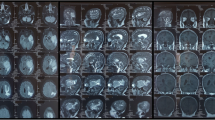Summary
Twenty-three patients with aneurysmal subarachnoid haemorrhage (SAH), who showed an ST segment elevation in their electrocardiograms (ECG), were examined.
There were 12 males and 11 females, with a mean age of 61 years. The clinical condition on admission was Hunt and Kosnik grade II in four, III in seven, IV in one, and V in 11 patients. Computerized tomography (CT) also revealed many cases of diffuse, thick SAH or intracerebral or intraventricular haematoma. Laboratory examinations including serum electrolyte, pH, and PaO2 revealed no abnormalities that might have influenced the ECG. Elevation in the levels of myocardial enzymes in serum was observed in two of the nine patients examined, although the elevation was only slight in one of them. Echocardiography, which was performed on several occasions on all patients, and cardiac catheterization, which was performed on eight patients, revealed a reduction in the motion of the left ventricular apex that was synchronous with ST segment elevation. This is the first report about these phenomena. No abnormalities were observed in the coronary artery. The elevated ST segment was normalized within one week in all patients, accompanied by normalization of the apical wall motion recorded on echocardiograms. In four patients, however, T wave inversion accompanied the improvement of the ST segment and was normalized within three months after the onset.
These results suggest that ST segment elevation in the acute stage of SAH reflects transient cardiac dysfunction rather than myocardial injury. In some patients, however, the elevated serum levels of myocardial enzymes or T wave inversion suggested the presence of myocardial injury. Close follow-up seems to be necessary in such cases
Similar content being viewed by others
References
Andreoli A, Di Pasquale G, Pinelli G, Grazi P, Tognetti F, Testa C (1987) Subarachnoid haemorrhage; frequency and severity of cardiac arrhytmias. A survey of 70 cases studied in the acute stage. Stroke 18: 558–564
Byer E, Ashman R, Toth LA (1947) Electrocardiograms with large, upright T waves and long Q-T interval. Am Heart J 33: 796–806
Conner RC (1970) Fuchsinophilic degeneration of myocardium in patients with intracranial lesions. Br Heart J 32: 81–84
Cruickshank JM, Neil-Dwyer G, Brice J (1974) Electrocardiographic changes and their prognostic significance in subarachnoid haemorrhage. J Neurol Neurosury Psychiatry 37: 755–759
Di Pasquale G, Pinelli G, Andreoli A, Manini G, Grazi P, Tognetti F (1987) Holter detection of cardiac arrhythmias in intracranial haemorrhage. Am J Cardiol 59: 596–600
Doshi R, Neil-Dwyer G (1977) Hypothalamic and myocardial lesions after subarachnoid haemorrhage. J Neurol Neurosurg Psychiatry 40: 821–826
Eisalio A, Parasalo J, Halonen PI (1972) Electrocardiographic abnormalities and some laboratory findings in patients with subarachnoid haemorrhage. Br Heart J 34: 217–226
Estanol BV, Badui ED, Cesarman E, Marin OSM, Loyo M, Vargas BL, Perez RO (1979) Cardiac arrhythmias associated with subarachnoid haemorrhage; prospective study. Neurosurgery 5: 675–680
Estanol BV, Loyo MV, Mateos JH, Foyo E, Cornejo A, Guevara J (1977) Cardiac arrhythmias in experimental subarachnoid haemorrhage. Stroke 8: 440–447
Fisher CM, Kistler JP, Davis JM (1980) Relation of cerebral vasospasm to subarachnoid haemorrhage visualized by computerized tomographic scanning. Neurosurgery 6: 1–9
Goldman MR, Rogers EL, Rogers MC (1975) Subarachnoid haemorrhage. Association with unusual electrocardiographic changes. JAMA 234: 957–958
Greenhoot JH, Reichenbach DD (1969) Cardiac injury and subarachnoid haemorrhage. A clinical, pathological, and physiological correlation. J Neurosurg 30: 521–530
Hammermeister KE, Reichenbach DD (1969) QRS changes, pulmonary edema, and myocardial necrosis associated with subarachnoid haemorrhage. Am Heart J 78: 94–100
Hunt O, McRae C, Zapf P (1969) Electrocardiographic and serum enzyme changes in subarachnoid haemorrhage. Am Heart J 77: 479–488
Hunt WE, Kosnik EJ (1974) Timing and perioperative care in intracranial aneurysmal surgery. Clin Neurosurg 21: 79–89
Hunt WE, Kassell N, Pertuiset B, Sano K, Teasdale G, de Villier JC, Drake CG (1988) Report of the World Federation of Neurological Surgeons Committee on a Universal Subarachnoid Haemorrhage Grading Scale. J Neurosurg 68: 985–986
Jennett B, Bond M (1975) Assessment of outcome after severe brain damage. A practical scale. Lancet 1: 480–484
Kreus KE, Kemila SJ, Takala JK (1969) Electrocardiographic changes in cerebrovascular accidents. Acta Med Scand 185: 327–334
Levin HD (1953) Nonspecificity of the electrocardiogram assoicated with coronary heart disease. Am J Med 15: 344
Marion DW, Segal R, Thompson ME (1986) Subarachnoid haemorrhage and the heart. Neurosurgery 18: 101–106
Pierpont GL, DeMaster EG, Cohn JN (1984) Regional differences in adrenergic function within the left ventricle. Am J Physiol 246: 826–829
Pollick C, Parker S, Tator C (1988) Left ventricular wall motion abnormalities in subarachnoid haemorrhage; an echocardiographic study. J Am Coll Cardiol 12: 600–605
Yuki K, Kodama Y, Onda J, Emoto K, Morimoto T, Uozumi T (1991) Coronary vasospasm following subarachnoid haemorrhage as a cause of stunned myocardium. J Neurosurg 75: 308–311
Author information
Authors and Affiliations
Rights and permissions
About this article
Cite this article
Kuroiwa, T., Morita, H., Tanabe, H. et al. Significance of ST segment elevation in electrocardiograms in patients with ruptured cerebral aneurysms. Acta neurochir 133, 141–146 (1995). https://doi.org/10.1007/BF01420064
Issue Date:
DOI: https://doi.org/10.1007/BF01420064




